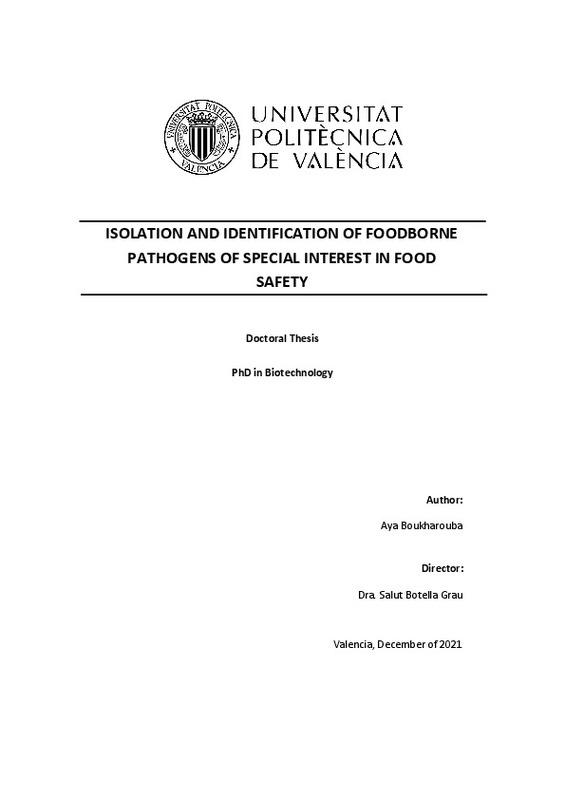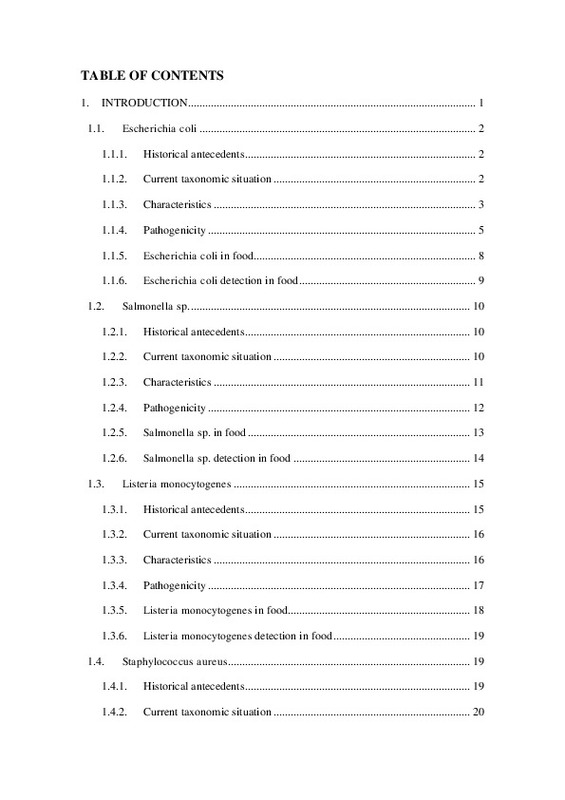- RiuNet repositorio UPV
- :
- Investigación
- :
- Tesis doctorales
- :
- Ver ítem
JavaScript is disabled for your browser. Some features of this site may not work without it.
Buscar en RiuNet
Listar
Mi cuenta
Estadísticas
Ayuda RiuNet
Admin. UPV
Isolation and Identification of Foodborne Pathogens of Special Interest in Food Safety
Mostrar el registro sencillo del ítem
Ficheros en el ítem
| dc.contributor.advisor | Botella Grau, Mª Salud
|
es_ES |
| dc.contributor.author | Boukharouba, Aya
|
es_ES |
| dc.date.accessioned | 2022-05-24T09:34:56Z | |
| dc.date.available | 2022-05-24T09:34:56Z | |
| dc.date.created | 2022-04-12 | |
| dc.date.issued | 2022-05-13 | es_ES |
| dc.identifier.uri | http://hdl.handle.net/10251/182828 | |
| dc.description.abstract | [ES] La seguridad alimentaria es una prioridad para la población y en la actualidad cobra mayor importancia por ciertas tendencias alimentarias como el consumo de alimentos crudos y la distribución generalizada de alimentos orgánicos, que pueden ser la causa de enfermedades transmitidas por alimentos. Para garantizar la seguridad alimentaria, la detección de estos microorganismos debe realizarse de manera rápida y eficiente. Par eso, el método de cultivo microbiológico se considera el oficial para la detección de estos patógenos. Sin embargo, adolece de importantes inconvenientes, ya que no solo requiere mucho tiempo, sino que también es laborioso y consume muchos recursos. Además, puede ser limitado con respecto a la detección de bacterias fisiológicamente alteradas y/o estresadas durante el almacenamiento y la conservación. En este trabajo se ha desarrollado un protocolo sencillo y rápido para la detección simultánea de E. coli, L. monocytogenes, S. aureus y S. enterica en alimentos, mediante la combinación de una etapa de co-cultivo en medio líquido y la detección por PCR múltiple. Se ha evaluado la eficiencia de varios medios de enriquecimiento y se seleccionó el agua de peptona tamponada como el medio óptimo para el co-cultivo de las cuatro bacterias diana. También se optimizaron las condiciones de PCR múltiple y se aplicaron tanto a co-cultivos como a muestras de alimentos inoculados artificialmente, lechuga orgánica y carne picada. Después de la optimización, la PCR múltiple desarrollada fue capaz de detectar las cuatro bacterias simultáneamente, hasta con una inoculación inicial de 10^0 UFC/mL. En presencia de ambas matrices alimentarias inoculadas, tras la etapa de co-cultivo, la PCR múltiple pudo detectar simultáneamente las 3 bacterias E. coli, S. enterica y L. monocytogenes, mientras que S. aureus se ha detectado por PCR simplex, a partir del mismo extracto de ADN del co-cultivo. Los resultados obtenidos permiten concluir que el uso de un paso de co-cultivo en Agua peptona tamponada, antes de la detección por PCR simple y múltiple, puede facilitar la detección simultánea de las cuatro bacterias potencialmente presentes en las matrices alimentarias. La presencia o ausencia de la bacteria diana en los alimentos se confirma en unas 30 horas, lo que reduce el tiempo requerido para la detección en comparación con el tiempo mínimo de 7 días por método cultural. Asimismo, permite reducir el número de medios de cultivo y reactivos, para el aislamiento e identificación de bacterias que no son detectadas por PCR y que no están presentes en las matrices alimentarias, lo que supone un importante ahorro económico. | es_ES |
| dc.description.abstract | [CA] La seguretat alimentària sempre és una prioritat per a la població i en l' actualitat cobra major importància per certes tendències alimentàries, com el consum d' aliments crus i la distribució generalitzada d' aliments orgànics, que poden ser la causa de malalties transmeses per aliments. Per garantir la seguretat alimentària, la detecció d' aquests microorganismes s' ha de realitzar de manera ràpida i eficient. Per a això, el mètode de cultiu microbiològic es considera l' oficial per a la detecció d' aquests patògens. Però, hi ha importants inconvenients, ja que no només requereix més temps, sinó que també és laboriós i consumeix molts recursos. A més, pot ser limitat pel que fa a la detecció de bacteris fisiològicament alterats i/o estressats durant l'emmagatzematge i la conservació. En aquest treball s'ha desenvolupat un protocol senzill i ràpid per a la detecció simultània d' E. coli, L. monocytogenes, S. aureus i S. enterica en aliments, mitjançant la combinació d' una etapa de co-cultiu en medi líquid i la detecció per PCR múltiple. S'ha avaluat l'eficiència de diversos mitjans d'enriquiment i s'ha seleccionat l'aigua de peptona tamponada com el medi òptim per al co-cultiu dels quatre bacteris diana. També es van optimitzar les condicions de PCR múltiple i es van aplicar tant a co-cultius com a mostres d'aliments inoculats artificialment, enciam orgànic i carn picada. Després de l'optimització, la PCR múltiple desenvolupada va ser capaç de detectar els quatre bacteris simultàniament, fins a una inoculació inicial de 10^0 UFC/mL. En presència d' ambdues matrius alimentàries inoculades, després l' etapa de co-cultiu, la PCR múltiple va poder detectar simultàniament els 3 bacteris: E. coli, S. enterica i L. monocytogenes, mentre que S. aureus s' ha detectat per PCR simple, a partir del mateix extracte d' ADN del co-cultiu. Els resultats obtinguts permeten concloure que l' ús d' un pas de co-cultiu en Aigua de peptona tamponada, abans de la detecció per PCR simple i múltiple, pot facilitar la detecció simultània dels quatre bacteris potencialment presents en les matrius alimentàries. La presència o absència del bacteri diana en els aliments es confirma en unes 30 hores, la qual cosa redueix el temps requerit per a la detecció en comparació amb el temps mínim de 7 dies per mètode cultural. Així mateix, permet reduir el nombre de mitjans de cultiu i reactius, per a l' aïllament i identificació de bacteris que no són detectats per PCR i que no estan presents en les matrius alimentàries, la qual cosa suposa un important estalvi econòmic. | es_ES |
| dc.description.abstract | [EN] Food safety is a priority for the population and is nowadays more important than ever due to certain dietary trends such as the consumption of raw foods and the widespread distribution of organic foods, which may be the cause of foodborne diseases. To ensure food safety, the detection of these microorganisms must be done quickly and efficiently. Although, the microbiological culture method is considered to be the official method for the detection of these food-borne pathogens, it suffers from significant drawbacks, such as time-consuming, laborious and expensive, in addition it may be limited regarding the detection of physiologically altered and/or stressed bacteria, during storage and preservation. In this work has been developed a simple and rapid protocol for the simultaneous detection of E. coli, L. monocytogenes, S. aureus and S. enterica in food, by combining a liquid co-culture step and detection by multiplex PCR. The efficiency of several enrichment media was evaluated and buffered peptone water was chosen as the optimal medium for the co-culture of the four target bacteria. Then, optimized multiplex PCR conditions were applied to both the co-cultures and the samples of artificially inoculated foods, organic lettuce and ground meat. After optimization, the developed multiplex PCR was able to simultaneously detect the four bacteria, up to an initial inoculation of 10^0 CFU/mL. In the presence of the two inoculated food matrices, after a co-culture step, the multiplex PCR could simultaneously detect the 3 bacteria: E. coli, S. enterica and L. monocytogenes, whereas, S. aureus has been detected by simplex PCR, from the same co-culture DNA template. The results obtained allow conclusion that the use of a co-culture step in Buffered Peptone Water, before detection by simplex and multiplex PCR, can facilitate the simultaneous detection of the four bacteria potentially present in the food matrices. The presence or the absence of the target bacteria in food is confirmed in approximately 30 hours, which reduce the time required for the detection compared to the minimum time of 7 days by cultural method. Also, it allows to reduce the number of culture media and reagents, for the isolation and identification of bacteria that are not detected by PCR and which are not initially present in the food matrices, which represents a significant economic savings. | es_ES |
| dc.format.extent | 107 | es_ES |
| dc.language | Inglés | es_ES |
| dc.publisher | Universitat Politècnica de València | es_ES |
| dc.rights | Reserva de todos los derechos | es_ES |
| dc.subject | Patógenos de transmisión alimentaria | es_ES |
| dc.subject | PCR múltiplex | es_ES |
| dc.subject | Enriquecimiento conjunto | es_ES |
| dc.subject | Alimentos ecológicos | es_ES |
| dc.subject | Alimentos listos para el consumo | es_ES |
| dc.subject | Agua de peptona tamponada | es_ES |
| dc.subject | Foodborne pathogens detection | es_ES |
| dc.subject | Multiplex PCR | es_ES |
| dc.subject | Co-enrichment | es_ES |
| dc.subject | Organic food | es_ES |
| dc.subject | Ready-to-eat food | es_ES |
| dc.subject | Buffered Peptone Water | es_ES |
| dc.subject | E. coli | es_ES |
| dc.subject | L. monocytogenes | es_ES |
| dc.subject | Escherichia coli | es_ES |
| dc.subject | Salmonella enterica | es_ES |
| dc.subject | Staphylococcus aureus | es_ES |
| dc.subject | Listeria monocytogenes | es_ES |
| dc.subject.classification | MICROBIOLOGIA | es_ES |
| dc.title | Isolation and Identification of Foodborne Pathogens of Special Interest in Food Safety | es_ES |
| dc.type | Tesis doctoral | es_ES |
| dc.identifier.doi | 10.4995/Thesis/10251/182828 | es_ES |
| dc.rights.accessRights | Abierto | es_ES |
| dc.contributor.affiliation | Universitat Politècnica de València. Departamento de Biotecnología - Departament de Biotecnologia | es_ES |
| dc.description.bibliographicCitation | Boukharouba, A. (2022). Isolation and Identification of Foodborne Pathogens of Special Interest in Food Safety [Tesis doctoral]. Universitat Politècnica de València. https://doi.org/10.4995/Thesis/10251/182828 | es_ES |
| dc.description.accrualMethod | TESIS | es_ES |
| dc.type.version | info:eu-repo/semantics/acceptedVersion | es_ES |
| dc.relation.pasarela | TESIS\12102 | es_ES |
Este ítem aparece en la(s) siguiente(s) colección(ones)
-
Tesis doctorales [5389]










